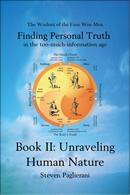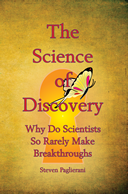What is a "Personality Theory" and Why Would You Want to Know?
Do you know anyone who's in therapy? Is anyone close to you going to school? Are you struggling in a romantic relationship? Are you or your friends raising kids or grandkids? If you've answered "yes" to any of these questions, then you've used a personality theory—each and every time you've tried to understand why someone did, said, thought, or felt what they did. You probably just never called your assumptions about human nature, a personality theory. They are though, and you live your life based largely on these somewhat invisible assumptions.
So what's different about a formal personality theory and why would you want to spend time learning about one? A personality theory is way to explain [1] human behavior, [2] experience, and [3] consciousness. Here, human behavior is what we do. Experience is what it feels like to do it. And consciousness is what allows us to do things and feel what it’s like to be doing them. From this, we can then define personality itself. Personality is the sum of all recognizable patterns of human experience and behavior.
So who are you and why do you do the things you do? This section of the site explores these questions. Why? Because the more you can recognize these patterns, the more you become the master of your life.
What is a Personality Theory (and why would you want to know) 2002
Determining Your Core Personality (an introduction)
Emergence Personality Theory - Just the Highlights (a quik list)
Question to Me on Being a Personality Theorist (helping with a college assignment)
A Professional Introduction to Emergence (a letter to a personality theorist) 2006
How All the Ideas on This Site Relate to Personality (the ways everything connects) 2005
How You Can Know If These Ideas Are True (how we test our theories) 2008
Most personality theories use linear collections of traits or behaviors to describe people. These collections of traits and behaviors are then seen as healthy or unhealthy; in effect, as either good or bad. The thing is, linearity does not exist in the real world. So these descriptions fall apart at the level of individual persons, especially when used to predict what these people will be like. More important still, these theories are by nature judgmental, in that they more reflect the values of the authors than any neutral observer's view.
These problems go away the minute you use fractal patterns to describe personality, especially if you focus your efforts on describing the effect need has on personality. After all, need, no logic, is what drives human nature, including our traits and behaviors. Thus the more you understand need, the more you understand yourself and everyone around you.
Using "Need" to Define Personality (The Idea Beneath an Incredible Thirty Minute Personality Test)
The Four Character Types (how we decide who has needs)
The Four Social Priorities:
~ Comfort (birth to age 6 months)
~ Neatness (age 6 months to 1 year)
~ Understanding (age 1 - 2)
~ Freedom (age 2 - 4)
the 4 Social Priorities in Relationships (how they affect how we get along)
The 4 Social Priorities in Classrooms (how they affect education and learning)
The 4 Social Priorities in Therapy (how they affect us with therapists)
How Knowing Your "Social Priorities" Can Improve Your Future (your social priorities)
It still amazes me that you can completely describe a person's core personality with just four fractal patterns. Here, by "core personality," I mean the part of people which would be left were they to heal all their injuries—their essence. The first pattern, character type, is the part of a person that decides who has needs. The second, a person's social priorities, describes what kinds of needs these needs are. The third, a person's decision tree, describes the process by which people decide to meet their needs. And the fourth, a person's gender identity, describes the direction and amount of force people use to execute these decisions.
Using Fractals to Define Personality (why use fractals?)
~ Character Type (core personality fractal 1)
~ Social Priorities (core personality fractal 2)
~ Decision Trees (core personality fractal 3)
~ Gender Identity (core personality fractal 4)
If you know your social priorities, then you know what you want in life. You also know what you're best at and what will make you happy. Equally important, you know what you're like at your worst and how best to get out of this state. All this from taking a few 12 minute tests. The thing is, for this to work, you'll need to understand "social priorities," what they are and where they come from. These articles focus on this kind of help.
the Baby Onion and Our Social Priorities (Getting to Know the "Real You")
Social Priorities and the Ladder of Shock (How Social Priorities Reveal States of Consciousness)
Personality Test: 4 Positively Biased, Social Priority, Six-Question Tests (personality test group 1)
Personality Test: Another 4 Positively Biased, Social Priority, Six-Question Tests (personality test group 2)
Personality Test: 4 Negatively Biased, Social Priority, Six-Question Tests (personality test group 3)
Personality Test: Another 4 Negatively Biased, Social Priority, Six-Question Tests (personality test group 4)
Making Your Own Social Priority Tests (How to Create Valid Test-Question Sets)
In Emergence Personality Theory, the various aspects of our personalities emerge in ten nested layers over time. These layers develop as a way for our minds to organize our interactions with life events. This series of drawings offers a historical perspective of this development.
The Natural Laws of Personality (how iron gets startled)
Where Symptoms Come From (blocked needs causes symptoms)
How the First Wound Happens (the wedding flash photo)
Over Time, Blocks Accumulate (many startling moments add up)
When Enough Wounds Accumulate, Layer 6 Appears (layer 6 - blocked needs)
Repeatedly Being Unable to See Needs Causes Symptoms to Appear (layer 5 - symptoms)
Repeatedly Experiencing Symptoms Creates Urges to Punish (layer 4 - eternal punishments)
Repeatedly Wanting to Punish Creates Layer 3 (time-limited punishments)
Making Excuses in Order not to Punish Creates Layer 2 (impersonal non existence)
Hearing Excuses Many Times Forms Layer 1 (personal non existence)
How Personality Evolves Over the Life Span (per Emergence Personality Theory)
The idea that personality resembles an onion is as old as dirt. Amazingly, no prior theorist has employed this wonderfully descriptive metaphor. If you then add to this that the onion's layers are organized the same way computer operating systems layer their functions, you end up with the first personality theory based on the structure of nested fractals, the real world accuracy of tipping-point based measures, and the symmetrical interdependence of logical geometry.
Emergence Personality Theory: an Introduction to the Onion
layer 10: Connections to the All (universal existence)
layer 9: Connections to Persons (connected duality)
The Birth Separation Moment (layers 8 & 7 emerge)
layer 8: Disconnections / Aloneness (universal non existence)
layer 7: Pure Needs (disconnected duality)
layer 6: Blocked Needs (visual non existence)
layer 5: Symptoms (hypervisual duality)
layer 4: Eternal Punishments (temporal non existence)
layer 3: Time-Limited Punishments (temporal duality)
layer 2: Punishing Questions, Excuses, and Explanations for not Punishing (impersonal non existence)
layer 1: Connections to Nothing (personal non existence)
This series of articles describes the developmental sequence in which the ten layers of personality emerge.
Before Conception - the Great Unknown (divine connections - layer 10 emerges)
Pregnancy as Our First Relationship (personal connections - layer 9 emerges)
The Second Birth Moment (disconnections - layer 8 emerges)
The Third Birth Moment (pure needs - layer 7 emerges)
The Origin of Our Wounds (blocked needs - layer 6 emerges)
Our Wounds Become Visible (symptoms - layer 5 emerges)
The Origin of All Crime (layer 4 emerges)
We Learn to Control Ourselves (layer 3 emerges)
We Intellectualize Our Blame (layer 2 emerges)
Our Suffering Disappears (layer 1 emerges)
The first drawings of emergence personality theory used four scales—the aloneness scale, the sense of self scale, the insight scale, and the evidence scale. These articles articulate these scales.
The First Scale: Aloneness / Connectedness (the aloneness scale)
The Second Scale: Inner Self - Outer Self (the sense of self scale)
The Third Scale: Outsight - Insight (the insight scale)
The Fourth Scale: Empirical - non Empirical Evidence (the evidence scale)
These three inventories were used as goals for the teachers in our school from 2005 through 2008. Each of these skills requires the person to recognize aspects of Emergence Personality Theory in real world situations. To wit, a theory is only as good as it is useful in the real world. These inventories test for this usefulness.
Emergence Master Teacher's Skills Inventory (level one)
Emergence Master Teacher's Skills Inventory (level two)
Emergence Master Teacher's Skills Inventory (level three)
Everything on this site is rooted in the same first principle, the idea that only complementary opposites can truly define real world things. At the same time, each pair of opposites must also combine into a single whole. We call this concept, "the two that are one."
The Six Basic Concepts of Conflict (the Two-That-Are-One)
The Six Concepts (explaining the conflict between sense and soul)
Rediscovering the Shaman's Wisdom (on sum-ism and holism)



